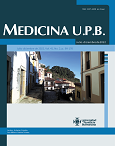Uso de emulsiones lipídicas en el tratamiento exitoso de un caso de intoxicación por difenhidramina
Contenido principal del artículo
Resumen
La difenhidramina tiene efectos antihistamínico anti-H1 específico y antimuscarínico que pueden ocasionar un desenlace fatal según la dosis total ingerida. Se reporta un caso de intoxicación por difenhidramina tratado de forma exitosa con emulsiones lipídicas a pesar de ingesta de dosis letal. Se presenta el caso de un paciente de 19 años que ingresó por intoxicación por difenhidramina a dosis de 25 mg/kg (1.5 g) después del tiempo de descontaminación, con toxidrome anticolinérgico, con neurotoxicidad, cardiotoxicidad (QRS y QT prolongados) y sin respuesta al enfoque inicial, se iniciaron emulsiones lipídicas y, a su vez, se logró alta temprana por evolución clínica favorable y resolución de la prolongación del intervalo QTc y del cuadro anticolinérgico. La emulsión lipídica es una opción terapéutica para disminuir la morbimortalidad y la estancia hospitalaria por contrarrestar la cardiotoxicidad y neurotoxicidad producidas por moléculas lipofílicas como la difenhidramina.
Referencias
Nemanich A, Liebelt E, Sabbatini AK. Increased rates of diphenhydramine overdose, abuse, and misuse in the United States, 2005–2016, Clinical Toxicology. 2021; 59(11):1002-1008.
Borowy CS, Mukherji P. Antihistamine Toxicity. [Updated 2021 Mar 12]. In: StatPearls [Internet]. Treasure Island (FL): StatPearls Publishing; 2021.
Gosselin S. Antihistamines and decongestants. In: Nelson LS, Howland MA, Lewin NA, Smith SW, Goldfrank LR, Hoffman RS. editors. Goldfrank’s toxicologic emergencies, 11e. New York, NY: McGraw-Hill; 2019.
Eckes L, Tsokos M, Herre S, Gapert R, Hartwig S. Toxicological identification of diphenhydramine (DPH) in suicide. Forensic Science, Medicine, And Pathology, 2013; 9(2):145–153.
Baker AM, Johnson DG, Levisky JA, Hearn WL, Moore KA, Levine B, et al. Fatal diphenhydramine intoxication in infants. Journal of Forensic Sciences, 2003; 48(2):425–428.
Campleman SL, Brent J, Pizon AF, Shulman J, Wax P, Manini AF, et al. Drug-specific risk of severe QT prolongation following acute drug overdose. Clinical Toxicology. 2020; 58(12):1326–1334.
Abdelmalek D, Schwarz ES, Sampson C. Life-threatening diphenhydramine toxicity presenting with seizures and a wide complex tachycardia improved with intravenous fat emulsion. Am J Ther. 2014;21(6):542–544.
Church MK, Maurer M. Antihistamines. Chemical Immunology and Allergy, 2014.
Radovanovic D, Meier PJ, Guirguis M, Lorent JP, Kupferschmidt H. Dose-dependent toxicity of diphenhydramine overdose. Hum Exp Toxicol. 2000; 19(9):489-95.
Barreto A, Santos J, Capitão A, Eusébio R, Pinheiro E, Machado A, et al. Assessment of diphenhydramine toxicity - Is its mode of action conserved between human and zebrafish? Environ Int. 2022; 164:107263.
Paneta M, Waring WS. Literature review of the evidence on intravenous administration of lipids in drug-induced cardiotoxicity, Expert Review of Clinical Pharmacology. 2019; 7:591-602.
Cherukuri SV, Purvis AW, Tosto ST, Velayati A. IV Lipid emulsion infusion in the treatment of severe diphenhydramine overdose. Am J Case Rep. 2019; 20:758-763.
Gosselin S, Lotte CG, Hoegberg RS, Hoffman AG, Stork CM, Simon HL, et al. Evidence-based recommendations on the use of intravenous lipid emulsion therapy in poisoning. Clinical Toxicology. 2016; 54(10):899-923.
Abdi A, Rose E, Levine M. Diphenhydramine Overdose with intraventricular conduction delay treated with hypertonic sodium bicarbonate and IV lipid emulsion. Western Journal of Emergency Medicine: Integrating Emergency Care with Population Health. 2014; 15(7):2014.8.23407.


